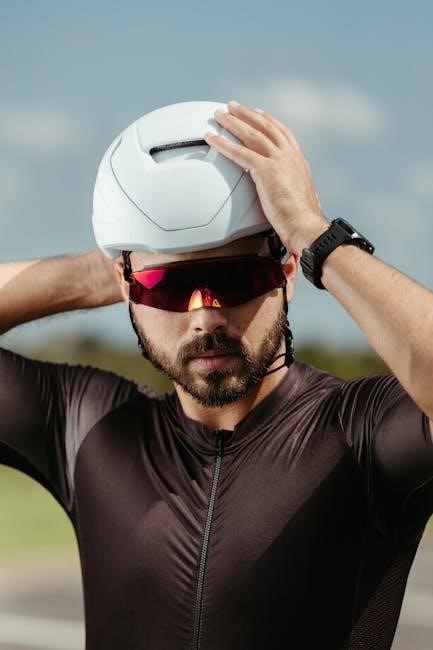Welcome to our comprehensive bike guide, designed to help you navigate the world of cycling with confidence. Whether you’re a seasoned rider or a newcomer, this guide offers expert insights and practical advice to ensure you find the perfect bike for your needs, understand proper sizing, and learn essential maintenance tips. Explore various bike types, accessories, and riding techniques to enhance your cycling experience.
1.1 Importance of Choosing the Right Bike
Choosing the right bike is crucial for comfort, performance, and safety. A well-suited bike ensures proper fit, reducing discomfort and injury risks. It also enhances riding efficiency and enjoyment. Whether for commuting, recreation, or sport, selecting the right bike tailored to your needs is essential for a positive cycling experience.
1.2 Overview of Bike Types and Purposes
Understanding bike types is key to making the right choice. Road bikes are built for speed on paved surfaces, while mountain bikes excel on rugged terrain. Hybrid bikes offer versatility for everyday riding, and kids’ bikes focus on safety and fun. Each type serves specific purposes, ensuring optimal performance for its intended use.
Understanding Bike Types
Exploring bike types helps you choose the perfect match for your riding style and terrain. From road to mountain bikes, each category offers unique features and benefits for optimal performance and comfort. This section will guide you through the main categories, ensuring you select the ideal bike for your adventures.
2.1 Road Bikes: Features and Benefits
Road bikes are designed for speed and efficiency on paved surfaces. They feature lightweight frames, aerodynamic designs, narrow tires, and drop handlebars for optimal performance. Ideal for long-distance rides, commuting, or training, road bikes offer a responsive and fast riding experience, making them a popular choice for both professionals and enthusiasts alike.
2.2 Mountain Bikes: Design and Use Cases
Mountain bikes are built for off-road adventures, featuring sturdy frames, suspension systems, and wide, knobby tires for traction on rough terrain. They excel in trail riding, downhill racing, and cross-country excursions. While they can handle some road riding, their design prioritizes durability and control on uneven surfaces, making them ideal for rugged outdoor enthusiasts.
2.3 Hybrid Bikes: Versatility for Everyday Riding
Hybrid bikes combine elements of road and mountain bikes, offering versatility for everyday riding. With upright handlebars, medium-width tires, and a comfortable frame, they excel for commuting, running errands, or casual rides on mixed surfaces. Their balanced design makes them ideal for riders seeking practicality and ease of use in various settings.
2.4 Kids’ Bikes: Size, Safety, and Fun
Kids’ bikes are designed with size, safety, and fun in mind. They come in various sizes based on wheel diameter and age ranges, ensuring a proper fit as children grow. Features like sturdy frames, reliable brakes, and colorful designs make them both safe and enjoyable for young riders to explore the world of cycling.

Bike Sizing and Fit
Proper bike sizing and fit are crucial for comfort, performance, and safety. Use sizing charts or professional fittings to determine your ideal bike size, ensuring optimal riding posture and efficiency.
3.1 How to Determine Your Bike Size
To determine your bike size, start by measuring your inseam and comparing it to manufacturer sizing charts. Consider your riding style and preferred handlebar height. Test rides are ideal for ensuring comfort and fit, as sizes can vary between brands. Proper sizing enhances performance and reduces discomfort during long rides.
3.2 Importance of Professional Bike Fitting
Professional bike fitting ensures optimal comfort, performance, and injury prevention. A trained expert will adjust your bike to match your body dimensions and riding style, improving efficiency and reducing strain. This personalized service is crucial for long rides and helps cyclists of all levels achieve their best performance and comfort.
3.3 Adjusting Your Bike for Maximum Comfort
Adjusting your bike for comfort involves tweaking handlebar height, saddle position, and pedal alignment. Ensure the saddle height allows a slight bend in your knee when the pedal is at its lowest point. Proper handlebar reach prevents strain on your back and shoulders, enhancing your riding experience and efficiency on the road.

Choosing the Right Bike for Your Needs
Choosing the right bike involves understanding your riding style, terrain, and budget. Explore bike types, features, and test rides to find your perfect match.
4.1 Assessing Your Riding Style and Terrain
Understanding your riding style and terrain is crucial for selecting the right bike. Determine if you’ll ride on roads, trails, or commute, and consider factors like frequency, distance, and terrain type. Road bikes excel on paved surfaces, while mountain bikes are ideal for rough trails. Hybrid bikes offer versatility for mixed surfaces. Assessing these elements ensures a bike that matches your lifestyle and preferences, providing comfort and performance where you need it most.
4.2 Key Features to Look for in a Bike
When selecting a bike, focus on features like frame material, braking systems, and gear options. Lightweight frames enhance performance, while disc brakes offer superior stopping power. Gearing should match your terrain—fewer gears for flat roads, more for hills. Consider saddle comfort, handlebar type, and suspension for a smooth ride. Warranty and after-sales support are also key factors to evaluate.
4.3 Budget Considerations and Value for Money
Set a clear budget and compare bikes within your price range. Consider long-term costs like maintenance and accessories. New bikes often come with warranties, while used bikes may offer savings but require inspections. Prioritize quality and durability to ensure value for money, balancing immediate costs with long-term benefits and performance.
Bike Accessories and Equipment
Enhance your cycling experience with essential accessories like helmets, lights, and locks. Explore bags, racks, and upgraded components to improve functionality, comfort, and performance for any riding style.
5.1 Essential Safety Gear: Helmets and Lights
Safety is paramount for every rider. A high-quality helmet protects your head in case of a fall, while lights enhance visibility, especially at dawn, dusk, or night. Choose a helmet with a snug fit and MIPS technology for added protection. Front and rear lights with adjustable brightness ensure you’re seen by other road users, reducing accident risks significantly.
5.2 Must-Have Accessories for Convenience
Enhance your cycling experience with practical accessories. A water bottle cage keeps you hydrated on long rides, while a multi-tool or spare tube ensures you’re prepared for minor repairs. Add a kickstand for easy parking and consider a phone mount to navigate or track your route effortlessly. These essentials make every ride more enjoyable and stress-free.
5.3 Upgrading Your Bike for Performance
Upgrade your bike for enhanced performance by improving key components. Consider replacing the crankset or wheels for better efficiency. Install high-quality bearings, like Shimano’s Hollowtech 2 system, for smoother operation. Adding a GPS device or power meter can optimize your training. These upgrades not only boost speed but also improve overall riding comfort and control.

Maintenance and Servicing
Regular maintenance is crucial for extending your bike’s lifespan. Clean and lubricate the chain, check tire pressure, and ensure proper braking function. Schedule professional servicing annually or after heavy use to address complex issues and ensure optimal performance. A well-maintained bike is safer, more efficient, and enjoyable to ride.
6.1 Regular Maintenance Tasks for Bike Longevity
Regular maintenance ensures your bike performs optimally and lasts longer. Clean and lubricate the chain, inspect tires for wear, and check brake pads. Adjust derailleurs and brakes as needed, and keep bolts tightened. Regularly cleaning the frame and wheels prevents rust and corrosion. Consistent care will keep your bike running smoothly and safely.
6.2 When to Seek Professional Servicing
Professional servicing is essential for complex repairs, such as gear systems or hydraulic brakes. If you notice unusual noises, difficulty shifting, or brake issues, consult a mechanic. After accidents or prolonged storage, a professional check ensures safety and optimal performance. Regular servicing also helps maintain your bike’s warranty and longevity.
6.3 DIY vs. Professional Bike Repairs
DIY repairs are cost-effective for minor issues like tire changes or brake adjustments, but complex problems require professional expertise. While DIY can save money, improper fixes may lead to safety risks or further damage. Professional servicing ensures quality and reliability, especially for critical components like gears and suspension systems.

Buying a Bike: New vs. Used
Deciding between a new or used bike involves weighing cost, quality, and personal preference. New bikes offer the latest technology and a perfect fit, while used bikes provide affordability and environmental benefits. Consider your needs and budget to make an informed choice.
7.1 Pros and Cons of Buying a New Bike
A new bike offers the latest technology, improved safety, and a manufacturer warranty. It ensures a perfect fit and professional assembly. However, it is more expensive and may have a higher environmental impact compared to buying used.
7.2 Benefits and Drawbacks of Purchasing a Used Bike
Purchasing a used bike can be cost-effective and environmentally friendly, offering significant savings. However, it may require a professional inspection to ensure quality and safety. Used bikes lack a manufacturer’s warranty, and hidden issues could arise, making it crucial to assess condition and history before buying.
7.3 Where to Buy: Local Shops vs. Online Retailers
Local bike shops offer personalized service, test rides, and professional fitting, ensuring a perfect match. Online retailers provide convenience, wider selections, and competitive pricing but lack in-person support. Consider your priorities: hands-on experience or cost and variety, and choose the option that best aligns with your needs and preferences.
Warranty and Return Policies
Understand manufacturer warranties covering parts and frames, typically ranging from 1-5 years. Retailers often provide return policies for exchanges or refunds, ensuring customer satisfaction and flexibility in purchases.
8.1 Understanding Manufacturer Warranties
Manufacturer warranties typically cover bike frames and components for 1-5 years, depending on the brand. Understand what is included, such as defects in materials or workmanship. Warranties vary, so review terms before purchase. Keep receipts and registration documents for claims. A valid warranty provides peace of mind and protects your investment.
8.2 What to Expect from Retailer Return Policies
Retailer return policies vary but often allow returns within 30 days of purchase. Bikes must typically be in original condition with all packaging intact. Some retailers may charge restocking fees, while others offer exchanges or store credit. Always review the return policy before purchasing to understand the terms and conditions.
8.3 Handling Returns and Exchanges
Handling returns and exchanges requires inspecting the bike’s condition and ensuring all original packaging and components are included. Contact the retailer’s customer support to initiate the process. Be aware of restocking fees and return windows. Understanding these policies helps avoid complications and ensures a smoother experience.
Safety Tips for Riders
Always wear a helmet, use lights, and follow traffic rules. Stay visible, signal turns, and avoid distractions. Be aware of road hazards and maintain your bike for safe riding.
9.1 Road Safety and Traffic Awareness
Always obey traffic signals and use hand signals to indicate turns. Stay alert, avoid distractions, and maintain a safe distance from vehicles. Be visible by using lights and reflective gear, ensuring drivers can see you. Anticipate hazards and ride defensively to minimize risks on the road.
9.2 Importance of Visibility and Signaling
Enhance your visibility with bright clothing, reflective gear, and front/rear lights. Always use hand signals: extend your left arm to signal left turns and down to indicate stopping. Clear communication helps drivers anticipate your actions, reducing accident risks and improving road safety for all cyclists.
9.3 Avoiding Common Hazards on the Road
Avoid potholes, gravel, and debris by staying alert. Be cautious of car doors opening suddenly and maintain a safe distance from vehicles. Anticipate unexpected movements from pedestrians and drivers. Use clear visibility and defensive riding techniques to minimize risks and ensure a safer cycling experience on shared roads.
Engaging with Local Bike Communities
Joining local cycling groups and participating in community events fosters connections and learning. Engage with experienced riders, attend workshops, and explore group rides to enhance your cycling journey and knowledge.
10.1 Benefits of Joining a Cycling Group
Joining a cycling group enhances your riding experience through shared knowledge, motivation, and camaraderie. Group rides offer safety, challenge, and fun, while experienced cyclists provide tips and inspiration; Being part of a community fosters accountability, helps you discover new routes, and accelerates your skill improvement in a supportive environment.
10.2 Participating in Local Bike Events
Participating in local bike events connects you with cycling communities, offering structured rides, workshops, and competitions. These events provide opportunities to meet experienced cyclists, learn new techniques, and gain inspiration. They also allow you to explore new routes, challenge yourself, and enjoy the camaraderie of shared cycling experiences in a fun and motivating environment.
10.3 Learning from Experienced Cyclists
Learning from experienced cyclists can significantly enhance your cycling journey. Seek advice on techniques, safety, and gear to improve your skills. Their insights can help you avoid common mistakes, adopt best practices, and gain confidence. Engaging with seasoned riders fosters growth and enriches your overall cycling experience through shared knowledge and encouragement.
Future Trends in Biking
The future of biking is shaped by innovation and technology. Electric bikes (E-Bikes) are rising in popularity, while smart bike technology and sustainable manufacturing are transforming the industry.
11.1 Rise of Electric Bikes (E-Bikes)
Electric bikes, or E-Bikes, are gaining popularity for their ease of use and eco-friendly nature. They offer a convenient option for commuting and leisure, with advanced technology improving range and performance. As environmental concerns grow, E-Bikes are becoming a sustainable alternative, appealing to a wide range of riders worldwide.
11.2 Smart Bike Technology and Innovations
Smart bike technology is revolutionizing cycling with features like GPS tracking, Bluetooth connectivity, and integrated apps. Innovations such as smart gears, automatic braking systems, and energy-efficient designs enhance performance and safety. These advancements cater to both casual riders and enthusiasts, making cycling more accessible, efficient, and enjoyable for all skill levels and preferences.
11.3 Sustainability in Bike Manufacturing
Sustainability in bike manufacturing focuses on eco-friendly materials, energy-efficient production, and reducing waste. Many brands now use recycled metals and carbon-neutral processes. This shift supports environmental conservation while offering consumers durable, high-performance bikes made with ethical practices, aligning with the growing demand for sustainable and responsible cycling solutions.

Final Thoughts and Recommendations
12.1 Summarizing Key Takeaways
Choosing the right bike involves understanding your needs, budget, and riding style. Proper sizing, essential accessories, and regular maintenance are crucial for safety and performance. Whether buying new or used, prioritize fit and comfort. Always test ride, and consider professional fitting for optimal cycling experience and long-term satisfaction.
